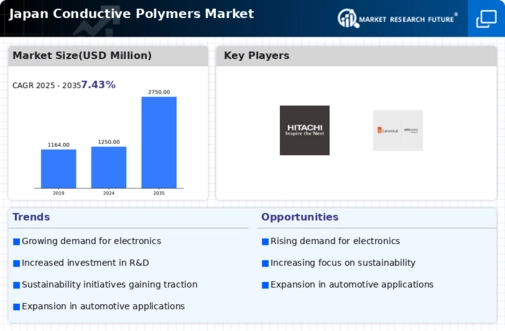The conductive polymers market in Japan is characterized by a dynamic competitive landscape, driven by innovation, sustainability, and technological advancements. Key players such as Mitsui Chemicals (Japan), Toray Industries (Japan), and Asahi Kasei Corporation (Japan) are at the forefront, each adopting distinct strategies to enhance their market positioning. Mitsui Chemicals (Japan) focuses on expanding its product portfolio through research and development, particularly in applications for electronics and energy storage. Meanwhile, Toray Industries (Japan) emphasizes strategic partnerships to bolster its capabilities in advanced materials, which is crucial for maintaining competitiveness in a rapidly evolving market. Asahi Kasei Corporation (Japan) appears to be leveraging its expertise in polymer science to innovate in areas such as biocompatible materials, which could open new avenues for growth.
The business tactics employed by these companies reflect a concerted effort to localize manufacturing and optimize supply chains, thereby enhancing operational efficiency. The market structure is moderately fragmented, with several players vying for market share, yet the collective influence of these key companies shapes a competitive environment that is both challenging and ripe with opportunities. Their strategies not only foster competition but also drive advancements in product offerings and technological capabilities.
In November 2025, Mitsui Chemicals (Japan) announced a collaboration with a leading tech firm to develop next-generation conductive polymers aimed at improving the performance of electric vehicle batteries. This strategic move is significant as it aligns with the growing demand for high-performance materials in the automotive sector, potentially positioning Mitsui as a leader in this niche market. The partnership is expected to enhance their R&D capabilities and accelerate product development cycles.
In October 2025, Toray Industries (Japan) unveiled a new line of conductive polymers designed for use in flexible electronics. This launch is indicative of Toray's commitment to innovation and its strategic focus on high-growth sectors. By diversifying its product offerings, Toray aims to capture a larger share of the burgeoning flexible electronics market, which is anticipated to witness substantial growth in the coming years.
In September 2025, Asahi Kasei Corporation (Japan) expanded its production capacity for conductive polymers, responding to increasing demand from the renewable energy sector. This expansion not only signifies Asahi's proactive approach to market trends but also underscores its commitment to sustainability. By enhancing production capabilities, the company is well-positioned to meet the needs of a growing customer base focused on eco-friendly solutions.
As of December 2025, the competitive trends in the conductive polymers market are increasingly defined by digitalization, sustainability, and the integration of AI technologies. Strategic alliances among key players are shaping the landscape, fostering innovation and enhancing supply chain reliability. The shift from price-based competition to a focus on technological advancement and sustainable practices is evident, suggesting that future competitive differentiation will hinge on the ability to innovate and adapt to changing market demands.













Leave a Comment